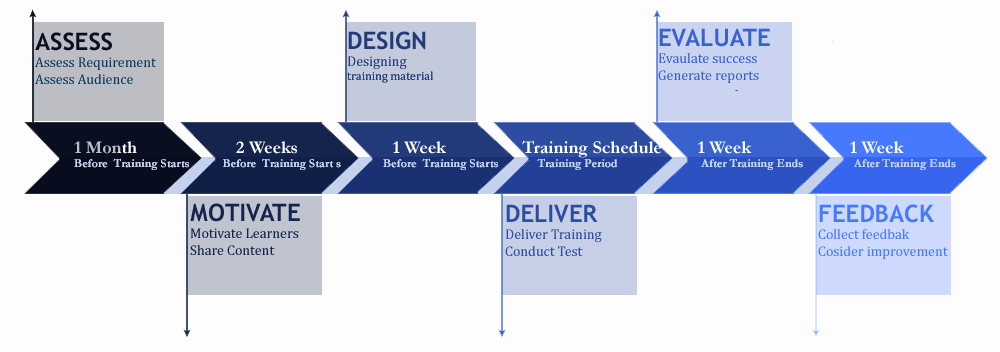Customized corporate training
The way new technologies are emerging, it has become very difficult for organization to find and hire required skilled resources. Companies try spending fund to train candidates but, still struggling in improving overall productivity.
- Applying a six step process to make corporate training programs more effective
- Assessing the requirement and associated attendees
- Time bound model and recursive in nature
- Designing unique content and delivery method as per the audience
- Multi mode training method
- Trainers with industry experience background
Why to prioritize employee training
Employee training programme is the effort to provide new hire with the technology knowledge, skills, and experience required to succeed in their role and achieve business goals. It is crucial to ensure the new hires are positioned to fulfill their potential. Without a structured and custom plan, informative curriculum, and routine check-ins, it becomes for new employees to perform well even though they were good in academic or previous organization. The training in onboarding is more than just gearing up new hires to perform their job but doing it in the right way to improve retention, increase employee performance and boost satisfaction. Also a solid training programme produces higher employee engagement and productivity

-
Assesing Training Requirement and Attendes
An assessment is helpful for an organization in many ways. With this effort, the organization can make clear expectation out of the training that what problem they want employees to solve after the training. What’s the performance gap between what they can do now and what they must be able to do after the training, would also be coming out in clear by having assesstment in place in the begining of the training. As part of this task, we analyze the knowledge gaps by conducting multiple tests and dividing employees into three categories (beginner, intermediate, and advanced). This helps in paying attention to individual employees and tailor training programs for them. Additionally, we try to talk to customers, partners, or anyone else who is in constant professional touch with the employees to know what they think is missing in terms of skill set.
-
Desiging Personalized Training
Creating personalized learning content and method is the key to successful employee training programs. When creating training programs, we focus on the needs of the employees, create training content that relates directly to business goals and break the training material into small chunks that are easier to understand, include real-time practice and opportunity for feedback during training. The whole training is put under a progressive timeline. To create an engaging learning experience, our training content includes storytelling and fun games into the training, descriptive images and useful videos to keep their attention for longer.
-
Delivering training
While delivering the training, we follow the training plan to do the progress as per the timeline that includes a schedule, the itinerary, and important milestones. A mix of subject expert trainers are engaged in delivering the training. The whole training programme is executed with a balanced session of theoretical and practical. Rewards on participate in training actively is another value added step we have taken. As a result, the more the employees enjoy the training program, the more they are likely to learn and implement their knowledge in real-time.
-
Analyze the performance
Analyzing how much employees learned in the training programme, we have an evaluation process as part of the whole programme. We do it in between the training after completing every big concept and one at the end of the training. There are two kind of test and evaluation we performed. One is open book test and other like a challenge test. A progress report is generated out the evaluation and submitted to the client.
-
Accepting the feedback for improvement
As communication is integral for improving the employee training process, we ask everyone involved for feedback and suggestions to improve the training process and ensure it fits the new hire’s needs. The feedback sessions are conducted after every module, so it can be reviewed immediately, and the necessary changes can be applied to the next session. Once employees have achieved the goals included in the training plan, they will need subsequent reinforcements to make sure they retain the new information long term. Keep employees engaged in the learning process by giving them ongoing professional development opportunities.
